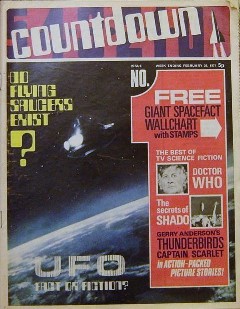TV Action
| Countdown | |
|---|---|

Countdown, issue 1
|
|
| Publication information | |
| Publisher | Polystyle Publications |
| Schedule | Weekly |
| Format | Ongoing series |
| Genre | Action, Adventure, Science fiction, Spy-fi, Techno-thriller |
| Publication date | 20 February 1971 – 25 August 1973 |
| Number of issues | 132 |
| Creative team | |
| Artist(s) | John M. Burns |
| Letterer(s) | Danny Fox (1972–73) |
| Editor(s) |
Dennis Hooper Peter Levy (assistant editor) Roger Perry (art editor) Bill Kidd (assistant art editor, 1971–72) |
Countdown was a British comic published weekly by Polystyle Publications – ultimately, under several different titles – from 1971 to 1973. The pages in each issue were numbered in reverse order, with page 1 at the end – a gimmick which was derived from the comic's title in order to create a "countdown" to the number one every week.
Under the title Countdown, the comic ran for 58 weeks, beginning with the issue cover-dated 20 February 1971. It was re-launched as TV Action + Countdown from issue 59 in 1972, dropping many of the original strips from Countdown and substituting new ones based on contemporary television programmes. After 100 issues, its title became simply TV Action. The final issue, number 132, was cover-dated 25 August 1973.
Initially it was a high-quality (but expensive) publication, featuring full-colour art on the cover and on many of the inside pages, and was printed on coated paper. From issue 59, Countdown dropped the glossy printing that had distinguished it, and reverted to cheap newsprint-quality paper, also abandoning the photogravure printing that had also been a feature until then.
Countdown was unusual in carrying both weekly serials and complete stories, rotating the latter among the various TV programmes that it featured. In addition, it carried a totally original strip, "Countdown", drawn by John M. Burns and including spacecraft designs from the 1968 film 2001: A Space Odyssey.
Another remarkable feature of Countdown was the inclusion of non-fiction articles about current space exploration, mostly written by Arnold Kingston. These included a level of technical detail more typical of the technical trade journals aimed at adult professionals: for example, in a 1971 issue of Countdown, the fourth installment of a series on Unmanned satellites, entitled Space Lighthouses explained the Doppler effect and gave details of US and Soviet navigation satellite programmes.
Polystyle were uncertain as to the most effective name for the new comic (an uncertainty which was to lead to five changes of name for it), initially registering it as Countdown and Rocket, although publishing the first nineteen issues under the title Countdown.
...
Wikipedia
